|
Years: 1983-1985
Class: Compact
Type: 3-door notchback
Country of Origin: Japan ````````````````````````` Host: GT1, 2, 3, 4 & 5
quick note: I
am sure I've driven & tested earliest (GT1 & 2) versions of this automobile, but cannot find the spec sheets...07/31/11
Price:
8,650 (GT1 Corolla Levin GT-Apex)
5,375 (GT4 Sprinter Trueno)
8,168
(GT5 Corolla Levin GT-APEX)
Construction: unit steel
Length: 165.5" // Width: 64.0" // Height: 52.6"
Wheelbase:
94.5"
Overhang: 5 feet 11 inches
Track: 53.5" [F] 53.1" [R]
Ground Clearance: 5.9"
Weight: 2,039 pounds (GT1
garage weight) 2,072 pounds (GT2 and GT4)
Steering: rack & pinion
Layout: front engine / rear drive
Tires:
F. Suspension: MacPherson struts,
coils, shox, anti-roll bar
R. Suspension: live axle, trailing linx, coils, anti roll-bar, panhard rod
Brakes: vented
discs [F] solid discs [R]
*GT4 car was probably given oil change before specs & testing
**GT5
car was given oil change + engine rebuild
Engine: 1.6 liter DOHC inline-4
Construction
Aspiration:
natural
FuelSystem: EFi + variable induction
Valves / Cyl: 2
Bore x Stroke: 3.19 x 3.03"
Compression: 9.4:1
````````````````````````````GT1``````````````````````GT4````````````````````````GT5`````````
Final
HP: 135 @ 6,300 127
@ 6,600 rpm 130 @ 6,500
Fnl Torque:
120 @ 4,900 110 @ 5,200 rpm
113 @ 5,200
Credits per HP: 60.50
42.32
62.83
Pounds per HP: 15.20
16.31 15.94
HP
per Liter: 85.0
80.0
81.9
GT1 (GT-Apex) Idle: 500 // Redline: 7,000 // RPM Limit: 8,000 GT4 (Trueno) Idle: 1,000 // Redline:
7,000 // RPM Limit: 7,500
GT5 (GT-Apex) Idle: 750 // Redline: 7,750 // RPM Limit: 8,000
Transmission: 5-speed manual
Differential:
limited-slip was option in r/l
`````````````````````GT1```````````````````````GT4````````````````````````GT5
0-60
mph: 8.733 seconds 10.216 seconds
10.850
0-100 mph: 19.100 seconds not available
26.369
400 M: 16.697 @ 92 mph 17.384 @ 84 mph
18.409 @ 84 mph
1 Kilom: 28.857 @ 120 mph 32.176 @ 108 mph
28.438 @ 122 mph
1/4 Mile: no test
no test
18.471 @ 84
1 Mile:
no test
no test 44.017
@ 120
Test Track Lap: N/A
2:55.729 1:07.880 (Daytona)
100-zero mph:
3.90 seconds 3.98 seconds
no test
Top Gear RPM @ 60 mph: 3,250 (GT1), 3,300 (GT5?)
GT1 Corolla Top Speed at
Redline
1st: 31 mph
2nd: 56 mph
3rd: 82 mph
4th: 115 mph
5th: 139 mph @ 7,300 rpm
GT4 Sprinter Top Speed at Redline
1st: 29 mph
2nd: 54 mph
3rd: 79 mph
4th: 111 mph
5th: 133
mph @ 7,300 rpm (aerodynamic & gearing limited)
GT5 Corolla GT Top Speed
at Redline
1st: 33.8 mph
2nd: 58.0 mph
3rd: 85.x mph
4th: 118.8 mph
5th: 135.3 mph @ 7,400
rpm
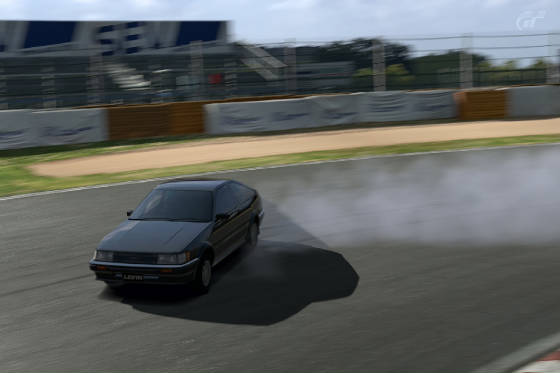
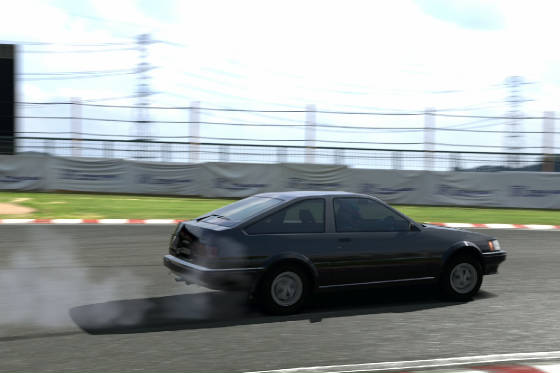
EXTERIOR / HISTORY----------------
The Corolla (known sometimes as the Levin or Sprinter Trueno in several countries outside America and
in the game) is one of the most popular cars of all time. Toyota started Corolla production at a time when fuel-efficiency,
quality, and practicality were of value over performance--and us Americans were getting in the habit of buying cars for their
longevity. Hence, the Corolla was a good purchase because it got good gas-mileage AND it lasted well over 100,000
miles.
When you're struggling with a mortgage, and just had a kid or two, you don't want to have to worry about your
car much for a couple years, sometimes more than a couple. The Corolla fit right in; sales of ‘econoboxes’ soared
during the '80s. The Corolla/Trueno may have its lacks, but it'll fit your budget perfectly since price is always
below $10,000 in any game except GT3.
Ever wonder where the name “Levin” comes from? It's a former race track in Levin, New Zealand.
The word “Corolla” means ‘crown of a flower’. Early Corollas had a badge that resembled a flower.
Levin Corollas won six consecutive class victories in the Bathurst 1000 KM race; an event held in Australia.
The first Corolla was produced in October 1966, but it wasn't till 1973 that the sportier Levin and Sprinter Trueno
series were released as both coupes and hatchbacks. These only appeared in Japan at first, but were later exported.
In
America, we got the SR-5, which was pretty much the same as what the rest of the world got, except ours didn't have twincam
engines until later. The AE86 series in our games was produced from 1983 till 1987, and was offered as
a 2-door coupe and 3-door notchback, though we only get the notch.
The looks of this one are unimpressive; some would say downright ugly! Many practical cars today, for
instance, manage to have sporty looks. The Corolla with its uncomplicated, trapezoidal shape is definitely straight
from the early '80s. Toyota's Sprinter Trueno, with its hide-away headlights, is somewhat cooler than the Corolla GT-APEX.
In either case, the car's body is also rather ungainly and unbalanced. There's a lot of weight towards the rear,
and it seems as though most of it is located in all the glass between the A-pillars, which makes the Corolla top-heavy.
One good thing is the availability of colors, and the variety of body styles is a plus as well,
although I'd still prefer a coupe for some racing. Whether you're playing GT1, GT2, GT4, or GT5 there's always a pick
of several of these cars from the used lot since they're rather common.
As mentioned, Levin and Trueno models
sport subtle differences like retractable headlights on some models, but open ones on others. In GT3, the selection is
rather uh...lame. There are basically just two colors to choose from ... white and red. Thankfully, it's possible
to win some others, and the white & black SS version (which first appeared in GT3 I think) is more
track-ready than any showroom-bought cars, with a lowered stance and much higher redline.
One awesome thing is the Corolla series' weight; or lack of it. The '85 Corolla GT-APEX in GT2
starts off at 2,039 pounds...slightly less in GT3. From game to game, we're always toying with just over
2,000 pounds.
Weight reductions in the second game
barely make a dent in the car's handling, but they're worth getting in GT1 or GT3, just 'cause the Corolla's career in
these games is shorter; and needs all the help it can get. The cars of GT4 or 5 don't absolutely need weight removed
to win lots and lots of races early on (including high-paying Special Condition events in GT4 or Seasonals in GT5), making
these machines virtual cash-cows! $@@$
All in all, this car may have been a good buy for the average Joe or Jane when it entered the automobile
market irl, but the Corolla / Levin/ Sprinter series looks and performs unimpressively. At first.
ENGINE / DRIVETRAIN--------------------
Here we have little to brag about, and I mean this as a compliment as well as a curse!
The 1.6 liter twin cam 4-cylinder engine produces most of its power
at higher revs, of course, yet lacks the torque to get moving quickly. Lack of torque (and slippery traction) are the two
things that hurt over and over during races. In real-life, these twincam engines also featured T-VIS,
a variable-inlet timing system. Some may scoff at the fact that these power-plants only make about 130 horsepower
when stock, but in 1983, this was pretty good for an economical/sporty 4-cylinder. Most Corolla models made even
less than 130.
GT1 allows room for an aftermarket turbo or 2 levels of naturally-aspirated tuning, yet only produces
just over 220 hp at the most after these modifications have been applied. The GT2 '83 GT-Apex will accept
a 2nd turbo...for a max of 264 hp @ 7,600 rpms.
Even a beginner might want something more after just a few hours of racing this slug! in GT3, there are two NA stages
and THREE turbos to choose from. All told, a Corolla in the 3rd game can top over 300 hp, which is as good
as it gets in the GT series.
GT4 offers the most variety: three NA stages, three turbos (Stages 1 & 2 can
be had from TRD, stages 1, 2, & 5 can be had from aftermarket tuning shops) and a supercharger. A full Stage 2 turbo
system garners just north of 250 hp in GT4.
One good thing that can be said here is that the motor is lightweight (and in the real-world, light at
the pump), and so understeer is very controllable at the low speeds the Corolla generates. Severe understeer is rare if you've
got the right tires (GT4 is the exception, of course). Also, the Corolla's engine sounds like a Sears Dremel® drill, which
makes it rather unique.
The gearbox as stock, close, or super-close formats leaves much to be desired. The spacing of the car's
stock gears is fine till we get to 5th, which is oddly spaced only slightly higher than 4th. This means that after building
up momentum down any long straight, the engine will be redlining moments after shifting into its highest speed. It's possible
that Toyota built the Corolla this way because at the time, most of the world was driving slower as speed limits were being
capped? Well at least in America this is true. 1st gear is also too short. It guarantees lots of wheelspin off the starting
mark, so rev that engine carefully at the beginning of a race!
These issues can be remedied by getting the full-custom racing gearbox, an expensive buy for many
folks who have no-doubt made this one of their first cars. Personally I just use stock gearing like 90% of the time. By the
time my Sprinter was making it to faster races, I had moved on to a more capable car, you see.
Also, if the engine has more than 200 hp, I find that the Corolla has a tendency to
burn rubber even BETWEEN 1st to 2nd gear gear shifts! Although this sounds cool, it's actually making the car lose
speed. There are two things we can do: 1} apply less throttle, obviously, and 2}. DON'T use the carbon driveshaft
or any of the flywheels. These components make the Corolla's drivetrain very light and easy-to-spin. Furthermore,
the racing muffler / air filter can be bolted on to add power, but the loss of torque (which is already low) and poor top-gear
ratio make this addition not very worthwhile for those who aren't so serious about this car. Again, this doesn't affect
the GT2 and GT3 Corollas much, so you're safe to use whatever power you want here.
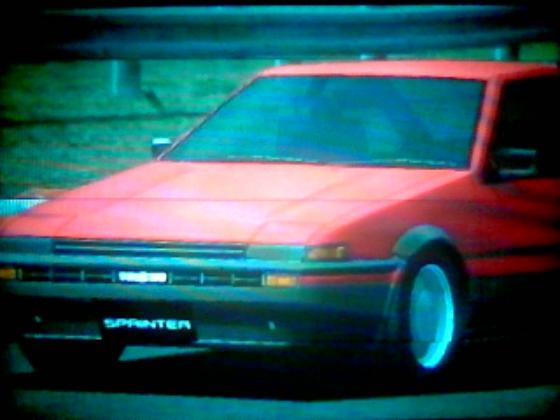
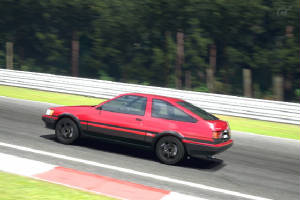
CHASSIS / HANDLING---------------------
Real-life Corolla race cars were extolled for their great handling, but at first the suspension under
our used mongrels seems obviously created for those needing a car that's simply a little nimble. The engine's
got a little pep thru city traffic, with a canny 55 mph ride down the highway. When the Corolla first hit America,
our highway system had just dropped most of its speed limits to 55, you see. So this car, in light of
the times during which it was manufactured, isn't anything we'd consider race-worthy!
Springs and dampers are calculated softly. After full racing modifications are made, it can still be
a challenge to tune and handle this one, even though it's not speedy. Body roll, diving, and pitching are astoundlingly
high. Hard stabilizers in GT1 are definitely needed if this car is your bag!
It
doesn't do well with its showroom (normal) tires, though this can be remedied somewhat with sports, semi-racing, or racing
slicks. Some say a Corolla is a good RWD car to learn from if you're a beginner, but since it slides easily and handles
rather poorly, this is a debatable issue. For more advanced drivers, it can be fun to toy around in if you want a challenge
in the maneuverability department, but the Corolla's lack of speed can always be a curse!
(Edit: I assume the above paragraph was written for GT1 since semi-racing tires are mentioned, back when I was totally
new to the series. I disagree with most of this nowadays {2024}. In fact the AE86 is completely maneuverable
in the first game. Easily pointed, even on normal tires, its traction from the rear is always reliable. I am driving a GT-APEX
with just over 200 hp, lately.
The Corolla demands a
modicum of control in this game, as bumps toss it and other cars can push it. Absolute beginners will have some problems
keeping this rear-drive machine pointed, but those with at least a couple weeks of solid experience will be fine.)
In
GT2, 3, 4, or 5 the semi-racing or sports suspension can be dialed so those dampers are rather stiff,
an attempt to kill some sloshiness; though at some tracks (Tahiti, Laguna Seca, Trail Mountain, Deep Forest and a few
others) damper settings higher than 3 or 4 make the car very twitchy over bumps--mostly since it's so light. In GT3, setting
those rear dampers over 5 will guarantee a bit of sliding out of corners. Traction is never something you can count
on when driving any of these in any GT game outside of GT1.
For all these reasons, the Corolla/Trueno series is highly sought by drifters; amateurs & pros alike. Its
rear-drive platform, plus the car's sneaker-like tires, make it easy to break traction. At these times, there are
just enough rpms (but not too much torque), which keeps maintaining a drift easier than in many other cars. This,
by far, is the car's best quality in the handling department! With the right settings, tires, and driving, grip-racing
is also possible. But the bottom line? Getting these cars to corner properly actually takes more work than getting
them to slide and drift, since it's very possible to drift these AE86 models even while they're completely stock.
GT4
is the great exception here. It's like comparing the gospel of John to those of Matthew, Luke, & Mark! In this
game, it seems as though there's a completely different author at work who hasn't copied from an earlier writer! Understeer
is great no matter what the settings. We can no longer reliably get the rear to slide-out at lower speeds, which means
drifting is also more difficult. Yes, the Corolla & Truenos are still very driftable in GT4, but they aren't as accessible
for getting loose to those with lesser skills. This was a huge bummer for me as I got excited about finally drifting
in 4, only to find the Corolla just as dull to drive as many other rear-drives.
Thankfully, PD brought back the magic
in GT5. The AE86es in this game feel pretty much like they did in GT3. Lots of drifting, sliding, and other such nonsense.
It's a hell of a lot of fun, of course, unless you're trying to be serious!
Even when the first Corolla
I drove in this game was on sport tires, it is always just a little bit recalcitrant out of those turns, or
at least it can be if I wasn't preparing as I exited turns with bits of countersteer. The understeer of GT4 is still here
in GT5, but truth is it's hardly noticed, as the Corolla gets sideways or sketchy from the rear over and over. Sometimes,
even while braking (when understeer would be expected in a vehicle which has more stability), the Corolla loses its grip from
the rear first!, causing some disasterous entry situations.
Brakes are sufficient in any game, but not phenomenol. They can be made stronger with the balance controller
and carbon-metallic pads, but the lack of speed this car produces won't make these an absolute buy for most racing situations.
Depends which game you've got and what situation you're facing, though.
My experience with the GT2 car (for instance) is
that the sports brake kit actually make the Corolla brakes TOO strong, which leads to a lot of sliding and fishtailing.
But I also just finished racing a Sprinter in GT4, which was equipped with a Racing Brake kit, and in this game it feels
a lot more stable. Perhaps this is an illusion to some extent, since under braking, all you'll get is understeer in this particular
game; unless you're really flying into some corner from a very high speed and lose control.
Go ahead and get slick tires (GT1, 2, or 3) if you've got the hp boosted up. You'd think you
wouldn't need them since power is so meager, but if you're not experienced with unwanted sliding, slicks are a good idea.
I just raced a Corolla Trueno GT-Apex last nite with Stage 2 NA tuning & racing parts (just 201 hp) and used sport tires,
but it wasn't easy. The car needed slick tires, but ... I'm stubborn. I like a wild ride sometimes. This top-heavy RWD behaves
like no other; it takes some getting used to.
I remember last year when I was a novice GT racer, needing to buy soft racing slicks early on, so don't
feel bad if you do the same.
In the 2nd and 3rd, games, it's a good idea to also get one of the
aftermarket differentials; the 1.5 setup does a good job at eliminating some squirrely-ness, making
drifts easier to maintain if that's your style. It won't cure the oversteer, though! For this, you might need
some help from a witch doctor or Shiva or something. Lol.
GT4 demands a 1-way or full-custom
differential. A 1.5 or 2-way diff will add hoards of understeer while slowing down. GT5 drivers have it the
toughest. No longer can a novice simply buy one of the fixed diffs of previous games as a quick-fix; now we can only get a
fully-customized unit, which a lot of novices will simply tune badly.
What it all boils down to is: this is a fun, nimble car if you're not trying to break any records. Don't
take it too seriously, and enjoy it for what it's worth. Which is typically anywhere from $3,000 to $9,000. :-)
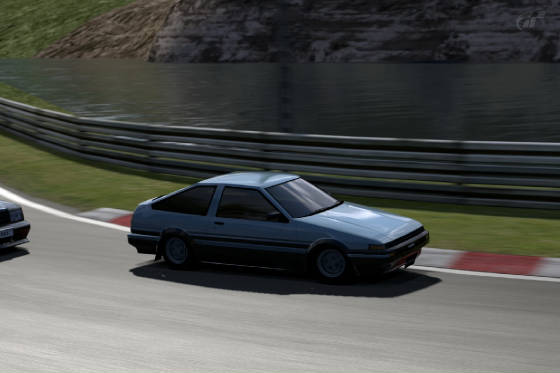
PROS---------------------------------------
1). Super-cheap! This car may be
a used piece of junk, but it's a CHEAP used piece of junk!
2). Light weight. Race kits can be had in GT1 or 2.
3). Variety: lots of color-schemes and several styles to choose from (except in GT3).
4). Isn't it fun pretending you're in the Initial D show? These cars may not be stellar, but
rate a 10 out of 10 so far as drifting goes. While the Corolla series lacks some control for grip-racing, they are perfect
for that slight loss-of-traction drifting demands.
5). GT4 & 5: wow, these cars sound great with exhaust upgrades!
6). GT3, GT4 & 5: a variety of engine & turbo upgrades help push these weaklings over 300 or 250 horsepower,
respectively. Supercharger can be had in GT5, as well.
7). GT4/5: fuel-thrifty.
CONS-------------------------------------------------
1). Low power, poor torque.
2). 5th gear is configured too short with a stock gearbox. Close-ratio gearing is sometimes
too short overall, depending which game is played, and what track you're at. Full-custom gears
needed for extended careers.
3). Poor handling, oversteer, and poor maneuverability despite the Corolla's typically lowish speed.
Lots of fishtailing guaranteed in any game except GT1 or GT4. A differential is typically needed immediately. Those
who aren't interested in a slippery, drifty drive should move on.
4). Engine upgrades don't guarantee Top Power. You'll never find an early '80s Corolla that tops 300 hp.
GT3 cars can get a 3rd turbo, which boosts their racing career immensely.
5). Top-heavy. Typically this means lots of leaning in turns.
6). GT4 mostly: we
finally have understeer, especially once we've equipped that necessary limited-slip. But even while stock, these cars aren't
exempt from plowing like they were in earlier games. GT5 cars also suffer from understeer, but oversteer often overshadows
this.
7). Trapezoidal body-work may turn some drivers off. The Sprinter Trueno with
its hide-away lights arguably isn't as plain as the Corolla Levin.
8). GT3 only: at 18,000 credits, the Trueno of this game costs way too much. It's no longer a 'Day
One' sort of car like it is in all other Gran Turismos. Still trying to figure out why.
Published: July 9, 2004
Re-edited: October 2, 2008 and February 22, 2009
Re-edited for GT5 content: July 31, 2011
|



